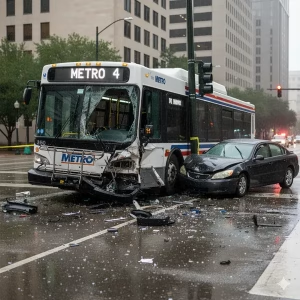 Unlike general motor vehicle accidents, crashes involving (liable or blameless) buses can get extremely complicated quickly. This is because the bus passengers are another direct party to the accident. Whether the bus hits or is hit by another vehicle, dozens of people can also be injured as a result, making an already difficult case that much more complicated. What’s more, buses can be driven by a private company or by a “common carrier.” Common carriers are organizations that offer their driving services to the public, like a regional transportation authority such as METRO in Houston, or the HOP in Central Texas.
Unlike general motor vehicle accidents, crashes involving (liable or blameless) buses can get extremely complicated quickly. This is because the bus passengers are another direct party to the accident. Whether the bus hits or is hit by another vehicle, dozens of people can also be injured as a result, making an already difficult case that much more complicated. What’s more, buses can be driven by a private company or by a “common carrier.” Common carriers are organizations that offer their driving services to the public, like a regional transportation authority such as METRO in Houston, or the HOP in Central Texas.
Did you know: METRO, or the Metropolitan Transit Authority of Harris County, is not owned by the city of Houston. Instead, it is owned by the Houston-Galveston Area Council (H-GAC).
Bus accidents are generally considered complicated cases because of how serious injuries can be, the number of victims involved, the fact that multiple insurance companies can be involved, the categories of buses, and the need to work with government or independent school districts (ISDs).
Common Carriers
As mentioned previously, any company or government organization that offers its transportation services to the public is considered a common carrier. This applies even if the services are offered by a private company like Greyhound or Highway Transport, two prominent Houston transportation companies.
So what doesn’t count as a common carrier?
Suppose a private oil-and-gas company operates a daily shuttle that transports its employees from a parking lot in Katy to a refinery in Baytown. The company owns and maintains the buses, but the service is not open to the public – only authorized employees can ride.
Even though the company transports people for a purpose related to its business, it is not a common carrier under Texas law because:
- It does not offer its service indiscriminately to the public;
- Passengers (employees) are not members of the general public; and
- The transportation is incidental to the company ‘s main business, not a commercial transport service.
Seme other examples of private carriers might include church vans or nonprofit buses, shuttles for nursing homes, or other event-specific charter buses.
Bus Injury Breakdown
Let’s talk about what might happen in a bus accident, depending on whether you were in a vehicle hit by the bus, in a vehicle that hit the bus or were a passenger on the bus at the time.
If You Were a Bus Passenger
With some exceptions, passengers are almost never considered at fault in a bus accident. When you board a public or private bus, the driver and the operating company owe you what is known as a “duty of care.” This means they must take reasonable steps to ensure your safety, such as maintaining the vehicle, following traffic laws, and driving attentively. This requirement is also one of the reasons why buses travel so slowly – if the driver accelerates or decelerates too quickly, a passenger may fall over or suffer blunt force or whiplash.
In the case of a bus accident, the question will often boil down to whether or not the bus driver acted negligently – for example, by speeding, running a red light, or being distracted. If the driver did one or more of these things, the bus company may be responsible for your injuries. In some cases, a third party may share responsibility, such as another driver who caused the crash or a maintenance contractor that failed to properly service the bus. However, if the driver was partially responsible, then the buses’ company may be responsible for some of the damages under Texas’ comparative negligence laws. In almost every case, however, the driver is not specifically liable for damages – transit authorities and bus companies are usually insured through commercial or government policies. That means that if you get injured on a bus, you’ll have to file a claim through those insurance providers.
Unfortunately, one of the most common complaints we have heard from potential new clients is “I filed a claim with the insurance company, but they never got back to me.” If that happens, you need to contact an experienced traffic injury attorney – it’s our job to make sure insurance companies pick up the phone.
If You Were Driving a Car Hit by a Bus
While a great deal of bus-related accidents in Houston occur on city streets and are therefore low-speed, crashes do sometimes happen on the highway, and due to the size and weight of the vehicle, drivers and passengers in smaller vehicles often suffer the most serious injuries. This was the case in 2015 when a Houston Independent School District (HISD) bus rolled off a Highway overpass, killing 2 and injuring 3.
In these cases, the same principle applies: the party responsible for causing the crash is liable for the resulting damages. If the bus driver was negligent or failed to follow traffic rules, the bus company’s insurance carrier may be responsible.* If another driver or hazardous road condition played a role, liability could be shared.
*Cases involving minors, including ISD buses differ significantly from traditional bus cases.
How Fault Is Determined
Thankfully, most buses have a camera (or set of cameras) for internal and external surveillance. Usually this footage is used to monitor passengers for dangerous or behavior, but it can also be used to prove an injury occurred, or which driver was at fault. This evidence can speed up cases significantly, even if getting ahold of the footage can be difficult, especially if the bus driver was responsible or there were minors aboard.
In a more general sense however, determining who is at fault in a bus accident depends on evidence and state traffic laws. Investigators and attorneys examine:
- Driver behavior: Was the bus driver distracted, fatigued, or speeding?
- Vehicle maintenance: Were the brakes, tires, or steering properly maintained? If they failed, who was the last person to work on those systems?
- Surveillance and dashcam footage: As mentioned, many buses are equipped with cameras that record inside and outside the vehicle.
- Witness statements: Passengers and bystanders can help clarify what happened.
- Police reports and black box data: These records often show vehicle speed, braking, and driver actions before impact.
A Note on Scope of Liability
Government agencies may be liable only when the employee was acting within the scope of employment and the conduct was not a discretionary decision (i.e. ministerial or operational acts may be scrutinized). If an act was discretionary, the immunity may shield the government. If the government admits liability in whole or part, then damages (for medical bills, property damage, lost earnings, pain and suffering) may be awarded, but subject to caps or limitations. Even if the claim is allowed, the government may raise defenses of necessity, contributory fault, or discretionary-function immunity (for how it chose to allocate resources, maintain roads, etc.)
Important: If the bus is publicly owned, there may be a shorter deadline to file a claim. If you’ve been hurt in a bus accident, call us, and we’ll help you figure out next steps.
Filing Deadline
We touched briefly on the fact that the filing deadline against a government-held transport company like the Houston METRO is shorter than the typical 2-year statute of limitations for personal suits. When dealing with a government entity, the injured party has to provide something called the “notice of claim,” or a detailed explanation of what happened, and request for compensation. There are a few rules.
- First, under Section 101.101 of the Texas Statutes, one must give written notice of the claim to the governmental unit no later than six months after the incident. However, for our readers, this is not the real deadline. The city of Houston requires notice of claim within 90 days, per Article IX, Section 11.
- This claim must be addressed directly to the mayor and city council.
- The notice must “reasonably describe” the injury, the time and place of the incident, and the incident itself. This can be difficult,
- If the entity has actual knowledge (i.e. it knew of the injury, its fault, and the parties) then formal notice may not always be strictly required. But courts tend to interpret “actual knowledge” narrowly, so relying on that is risky.
- If notice is late or defective, the government can raise a plea to the jurisdiction to dismiss the claim.
For school districts (ISDs), because they are units of local government, the six-month notice rule applies. It is generally advisable to send the notice promptly (e.g. via certified letter to the superintendent or the district’s risk management).
Knowing how to what to put in a claim, how to structure it, and how to get all of the information needed to write on is difficult. That’s why the Law Offices of Hilda Sibrian are here to help you.
Getting Legal Help After a Bus Accident
Bus accident claims are often more complex than regular car crashes. Multiple insurance companies, government agencies, or private contractors may be involved, and each may try to shift blame to avoid financial responsibility.
The Law Offices of Hilda Sibrian helps individuals who were hurt in these types of accidents pursue the financial recovery they need for medical expenses, lost wages, and long-term care. Our team investigates the crash thoroughly, handles all communication with insurers, and fights for a fair outcome. Because we work on a contingency fee basis, we don’t get paid until you win – and only for an agreed upon percent after we sit down to discuss your case.
If you were injured in a bus accident – whether as a passenger or another driver – you do not have to face the insurance process alone. Contact The Law Offices of Hilda Sibrian today at 713-714-1414 or through our online contact form for a free case evaluation. The Law Offices of Hilda Sibrian serve the entire Houston metropolitan area, including the cities of Bellaire, Clear Lake, Cleveland, Deer Park, Cypress, Pasadena and of course Houston proper.









